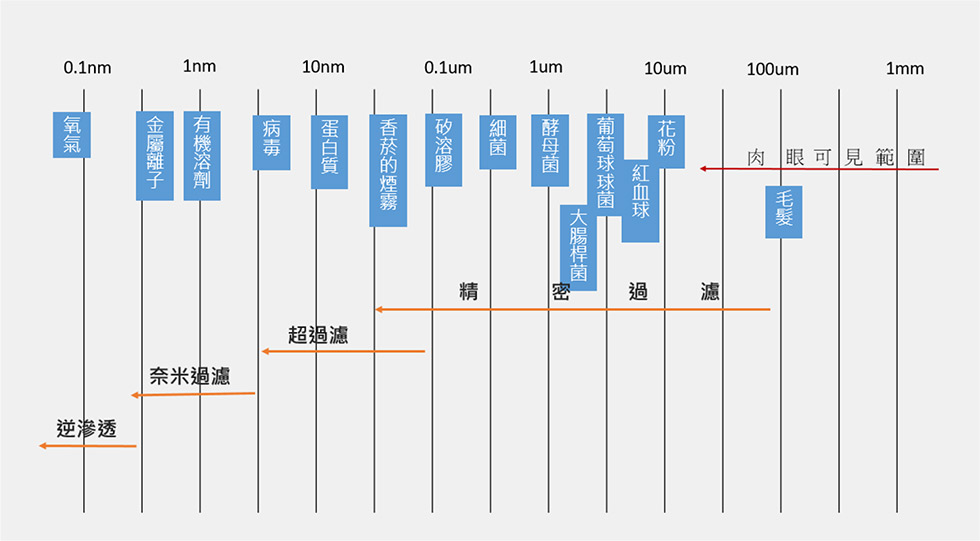FAQ
ROKI Filter
MoreWhat is Micron Filtration(Microfiltration)?
Classify the filtration field according to the size of the particles that need to be screened, and the filtration level can be divided into micron filtration (Microfiltration, MF)、Ultrafiltration (Ultrafiltration, UF)、Nanofiltration (Nanofiltration, NF)、Reverse osmosis (Reverse osmosis, RO) etc.。

Purchasing filter elements and conforming to equipment installation, you should pay attention to those specifications and sizes?
The composition of the filter core can be roughly divided into :
Filter housing、Inner cylinder (center column)、 filter material、support material、 end cap (filter joint)、gasket or Oring、 length and inner and outer diameters, etc.
welcome to inquire,We will provide a complete consulting service.
Filter housing、Inner cylinder (center column)、 filter material、support material、 end cap (filter joint)、gasket or Oring、 length and inner and outer diameters, etc.
welcome to inquire,We will provide a complete consulting service.
There are many kinds of filter end caps (joints), how to choose?
The filter element is installed in the filter equipment, under the pressure of the fluid, it needs to be fixed in a good way to ensure no leakage, so as to avoid the failure of the filter.
End caps are the best choice to ensure fixation and tightness. There are many kinds of end caps in industrial use. The choice should conform to the style that can be installed by the original equipment, and consider that the Oring or gasket material has sufficient chemical resistance.
End caps are the best choice to ensure fixation and tightness. There are many kinds of end caps in industrial use. The choice should conform to the style that can be installed by the original equipment, and consider that the Oring or gasket material has sufficient chemical resistance.
Vacuum Cup
MoreRubber material properties and use
| Material distinction / characteristic |
NR natural rubber |
NBR NBR |
EDPM Ethylene Propylene Rubber |
PU Polyurethane |
Silicone Silicone rubber |
KFM (VITON) fluororubber |
| Advantages and disadvantages of material | Advantages: Excellent elasticity and anti-wear and anti-tension properties. | Advantages: Oil resistance (depending on the amount of acrylonitrile), heat resistance and consumption resistance.HNBR has more high temperature resistance. XNBR is more wear resistant. | Advantages: weather resistance, oxidation resistance and solvent resistance, high temperature resistance. | Advantages: waterproof, good anti-slip, corrosion resistance, superior elasticity and stretchability. | Advantages: high temperature and low temperature are better than ordinary materials, and good usability. There are also food-grade pacifier materials and medical-grade silicone as materials. |
Advantages: heat resistance, corrosion resistance and high temperature resistance are better than other materials. Fluorine rubber (FKM) has different trade names in different brands. The FKM trade name of American DuPont TM Viton ®. The FKM product name of American 3MTM company is DyneonTM. The trade name of Nissho Daikin® is DAI-EL |
| Disadvantages: lack of anti-oxidation and anti-odor ability, it is necessary to add anti-aging agent and anti-oxidation. | Disadvantages: It is not good to use at low temperature and it is easy to deteriorate. | Disadvantages: oil resistance, poor bending crack resistance, poor adhesion. | Disadvantages: poor heat resistance and alkali resistance, limited use time, easy to turn yellow, high unit price without yellowing, heavy pungent smell. | Disadvantages: poor oil resistance. | Disadvantages: higher price | |
| Main production use | Tires. Shock absorbers. Soles... | O-RING (oil seal). Roller. Oil resistant tube... | Wiper. Gasket. | Mechanical shock absorbers and metal buffer gaskets. | Upholstery. Electronic products, food supplies. Medical supplies. | O-RING (oil seal). Sealing gasket |
| Temperature range | 40˚~+70˚ | -35˚~+100˚ | -55˚~+125˚ | -40˚~100˚ | -40˚~200˚ | -15˚~250˚ |
| Softness range Hardness Shore A | 30˚~90˚(HS±5˚) | 55˚~70˚(HS±5˚) | 70˚~90˚(HS±5˚) | 35˚~70˚(HS±5˚) | 35˚~70˚(HS±5˚) | 70˚~90˚(HS±5˚) |
| pull | ★ | ◎ | △ | ★ | ◎ | ★ |
| elasticity | ★ | ◎ | ◎ | ★ | ★ | △ |
| Extensibility | ★ | ◎ | ◎ | ★ | ★ | ◎ |
| wear resistance | ★ | ★ | ★ | ★ | X | △ |
| Aging resistance | X | ◎ | ★ | X | ★ | ★ |
| oil resistance | X | ★ | X | ★ | X | ★ |
| water resistance | ★ | ★ | ★ | X | ★ | ★ |
| Ozone resistance | X | X | ★ | ◎ | ★ | ★ |
| acid resistance | △ | ◎ | ★ | △ | ◎ | ◎ |
| Alkali resistance | △ | ◎ | ★ | X | ★ | △ |
| Solvent resistant | △ | X | ★ | X | ◎ | ★ |
| Anti-slip | ★ | ★ | ★ | △ | △ | ★ |
| Insulation | ◎ | △ | △ | ◎ | ★ | △ |
| Antistatic treatment 106~8th power |
V | V | ||||
| No trace treatment (COATING) | V | V | V | V | V | V |
★excellent ◎fine △ ordinary X inferior V can be produced

